The backhand block against a loop or drive is a stroke used by beginners and advanced players alike to control a powerful attack made by the opponent.
The idea behind this stroke is to use a minimal backswing and follow through, and rely on the correct bat angle to control the opponent’s topspin and speed. This will cause the ball to be rebounded from the bat in a low forward trajectory, with a little or no topspin. Once the basic block is mastered, the amount of backswing and follow through can be increased to make the block closer to a backhand counterhit.
Ready Position
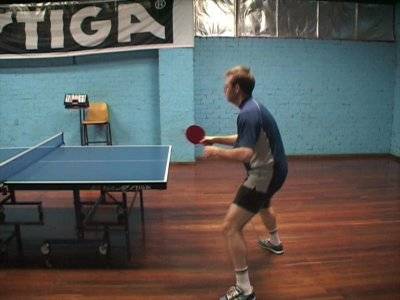
© Greg Letts
Points to look for:
- The feet are placed with the right foot slightly further back than the left foot.
- Most of the weight is on the balls of the feet to allow quicker movement. Too much weight on the heels will slow down movement, and too much weight on the toes will affect balance.
- The weight is evenly distributed between the left and right legs.
- The knees are bent and the feet are around one and a half times shoulder width apart. The torso is also leaning slightly forward. This gives a lower center of gravity for better balance, and allows for easy movement in all directions.
- Shoulders are in line with the legs, with the right shoulder slightly behind the left.
- The arms are held roughly shoulder width apart, with around a 90 degree angle at the elbow.
Middle Of Backswing
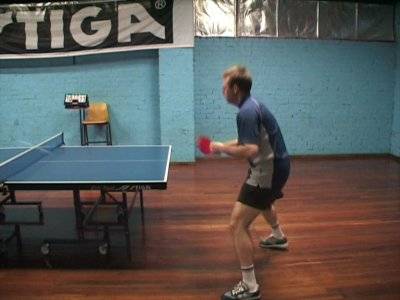
© Greg Letts
The ball is coming to the backhand side and the decision has been made to play a backhand block. The backswing begins the stroke.
Points to look for:
- The right foot and leg have turned to the left, in preparation for putting more bodyweight on the left leg.
- The hips, waist and shoulders have also stayed still, and the head is facing forward watching the ball.
- The bat has moved backwards and downwards at this point.
- The left arm has not moved significantly, and will not do so throughout the stroke. Since very little weight is shifting, it is not required to move it for balance, and it is better left in the same position.
End Of Backswing
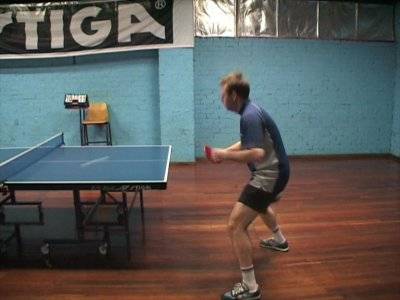
© Greg Letts
The ball has bounced on the table, and the backswing has finished.
Points to look for:
- The bodyweight has moved a little onto the left leg, but is still fairly even.
- The left arm has not moved, and the right arm has bent at the elbow to the left, so that the forearm is at a 45 degree angle to the endline of the table.
- Notice that the shoulders and waist have stayed square to the line of the ball path.
- Both shoulders have lowered a little, as the player continues to get into position. The right hand is at the height of the top of the net. Note that the right hand is around six inches or so to the right of the left hand horizontally.
- The head has lowered to allow the player to keep watching the ball comfortably and closely.
- The player is directly behind the ball, with the ball roughly in the centre of his body.
- The angle of the bat is about 80 degrees, with the bat face squarely facing the ball, which is coming from the opponent’s backhand corner.
Beginning Of Forward Swing
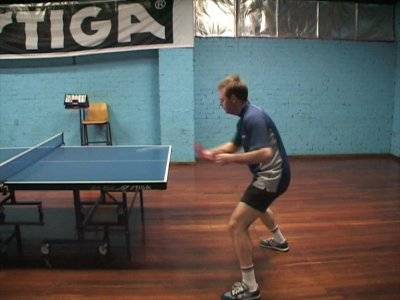
© Greg Letts
The player has begun to move his bat forward to contact the ball.
Points to look for:
- Since the player is blocking the ball, the length of the backswing is minimal – less than a foot.
- The player is continuing to watch the ball closely.
- The right elbow has moved forward as part of the stroke, and is now visible.
Contact With The Ball
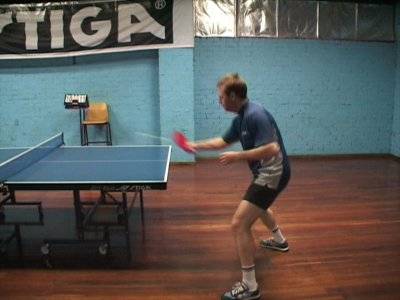
© Greg Letts
Contact has been made with the ball.
Points to look for:
- The player has watched the bat contact the ball.
- The hips, waist and shoulders have not turned appreciably from their position at the end of the backswing.
- The forearm and bat are moving mainly forward and a little upwards, as shown by the slight blurring in the photograph.
- If the ball was compared to a clockface, the bat has made contact at a point roughly between the numbers 1 and 2, while the bat was moving mainly forwards and slightly up. Note that the angle of the bat remains at around 70-80 degrees. This movement makes the ball go mainly forwards and a little upwards, with a light amount of topspin generated by the small brush of the ball.
- Contact has been made between the left hand side of the torso and the middle of the body.
End Of Follow Through
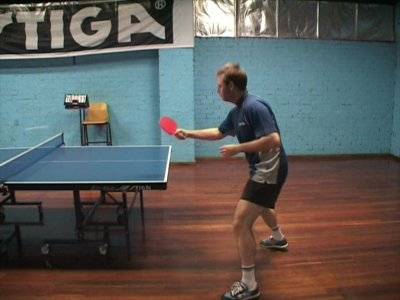
© Greg Letts
The forward swing has come to an end, and the ball is on its way.
Points to look for:
- The player is now watching his opponent at the other end of the court, rather than the flight of the ball.
- The hips, waist and shoulders are a little higher than the original ready position, since the legs have pushed up a little to help lift the ball.
- The bat has not travelled much more than a foot or so forwards during the whole forward swing.
Start Of Return To Ready Position
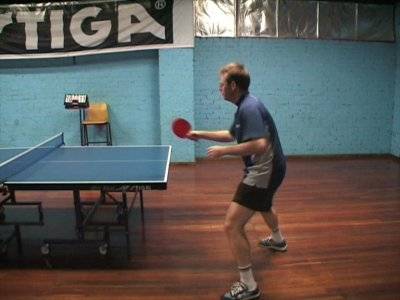
© Greg Letts
The player is now beginning to return to his basic ready position.
Points to look for:
- The shouders are turning back towards being square to the line of play, as the right elbow is being brought back towards the side of the body.
- The bat has been returned to a neutral position, with the edge of the bat upright and the tip facing forward to the line of play, so that a forehand or backhand can be played with ease.
- The player is now watching his opponent play his stroke.
Return To Ready Position

© Greg Letts
The player returns to his ready position before the next stroke.
Points to look for:
- The right foot has turned back to the right as the weight of the body has come back to an even distribution.
- The player simply had to bring his right arm backwards to have his bat back into the ready position. Note that the bat is pointing forward in a neutral position, and is not left in place for another backhand.
- The waist, hips and shoulders have returned to their original position.
- His knees are bent as he begins to move towards his next stroke.
- His bodyweight is again evenly distributed between his left and right legs, and on the balls of his feet.

